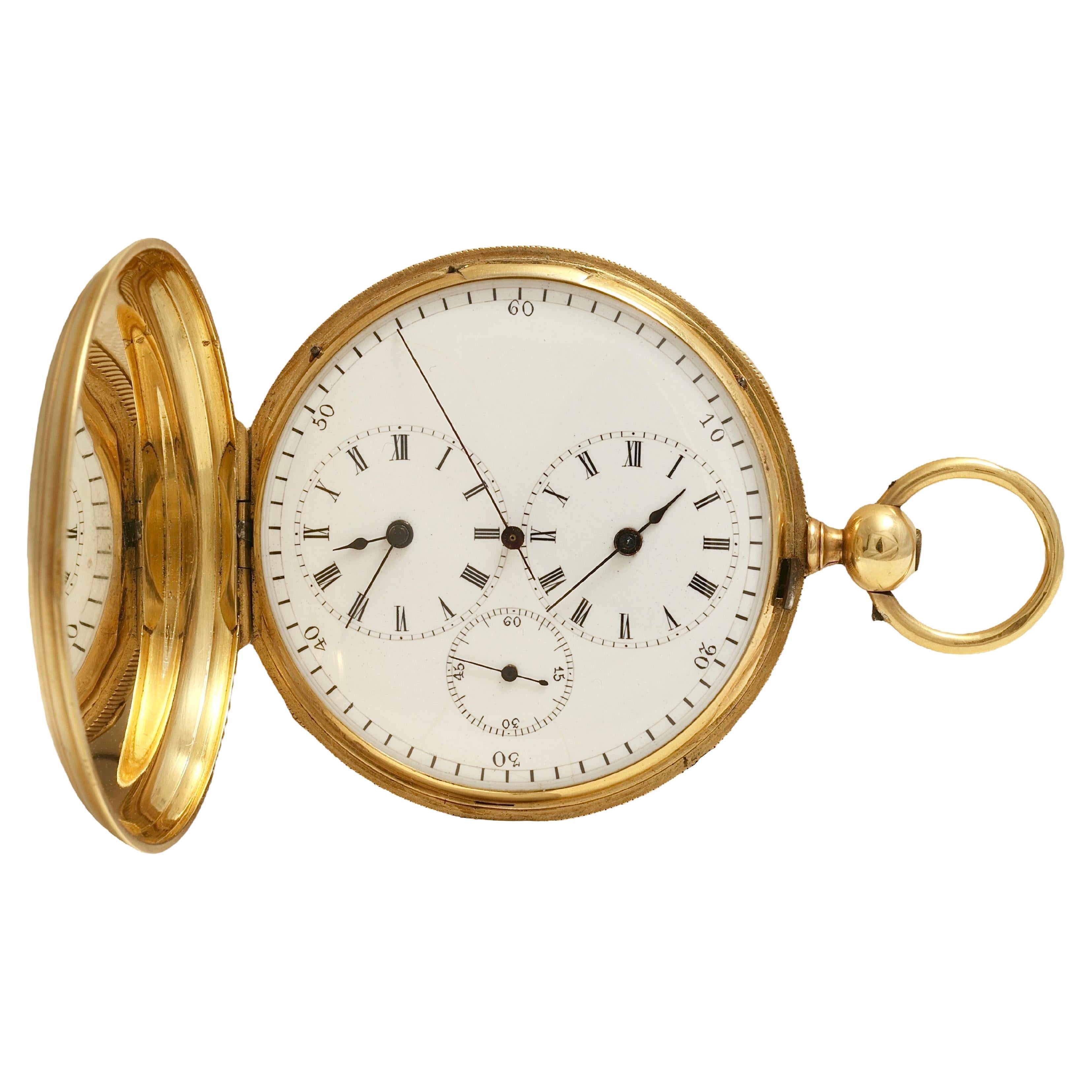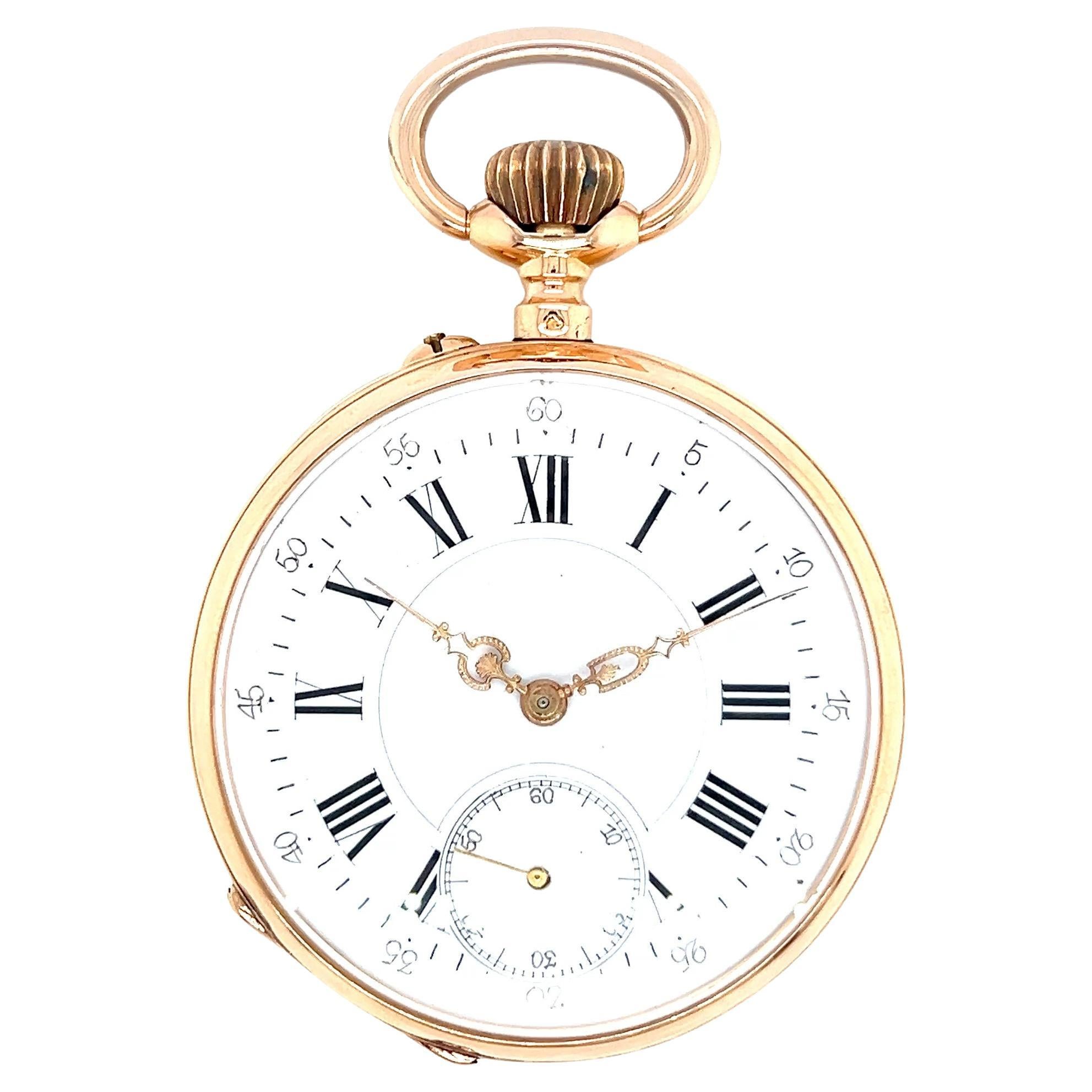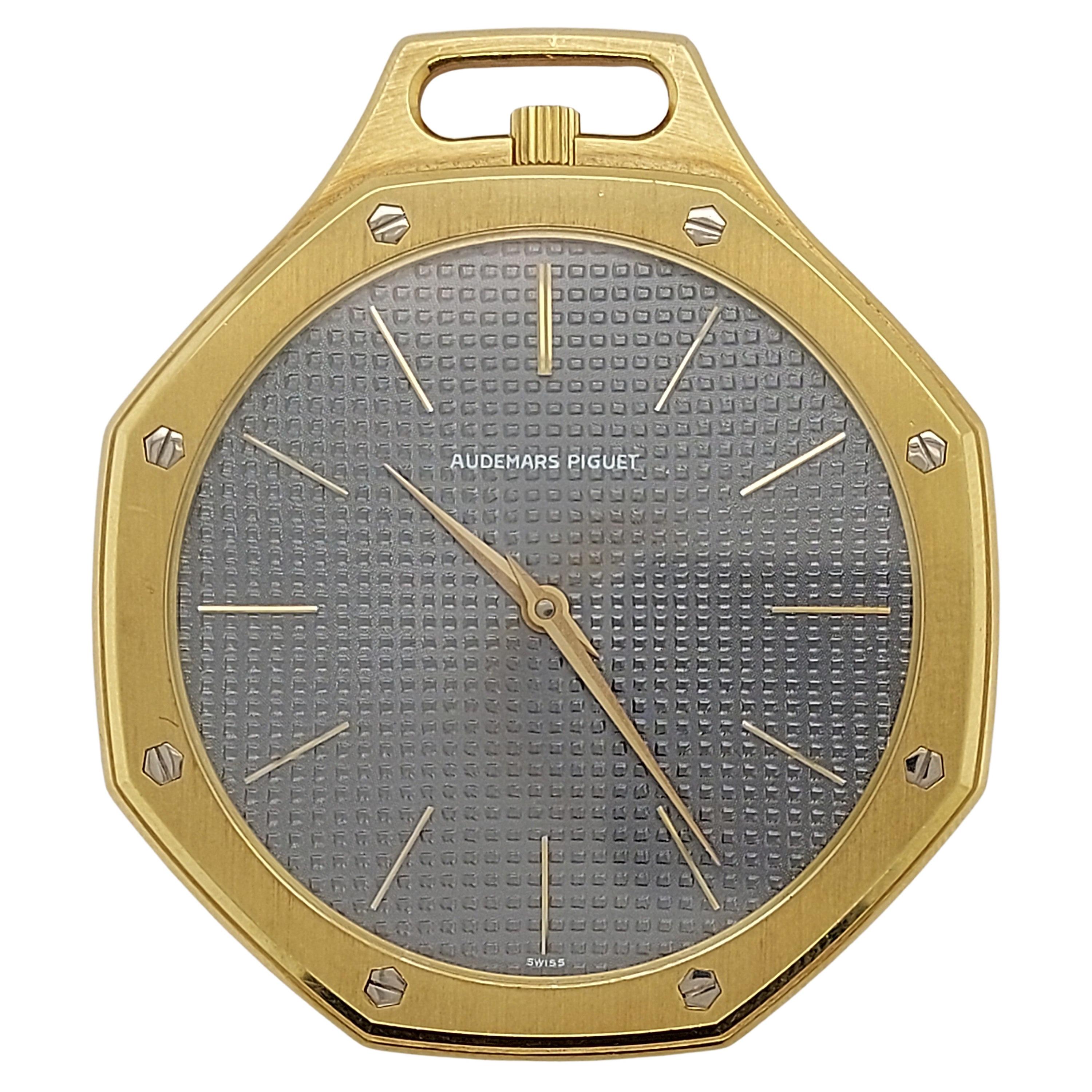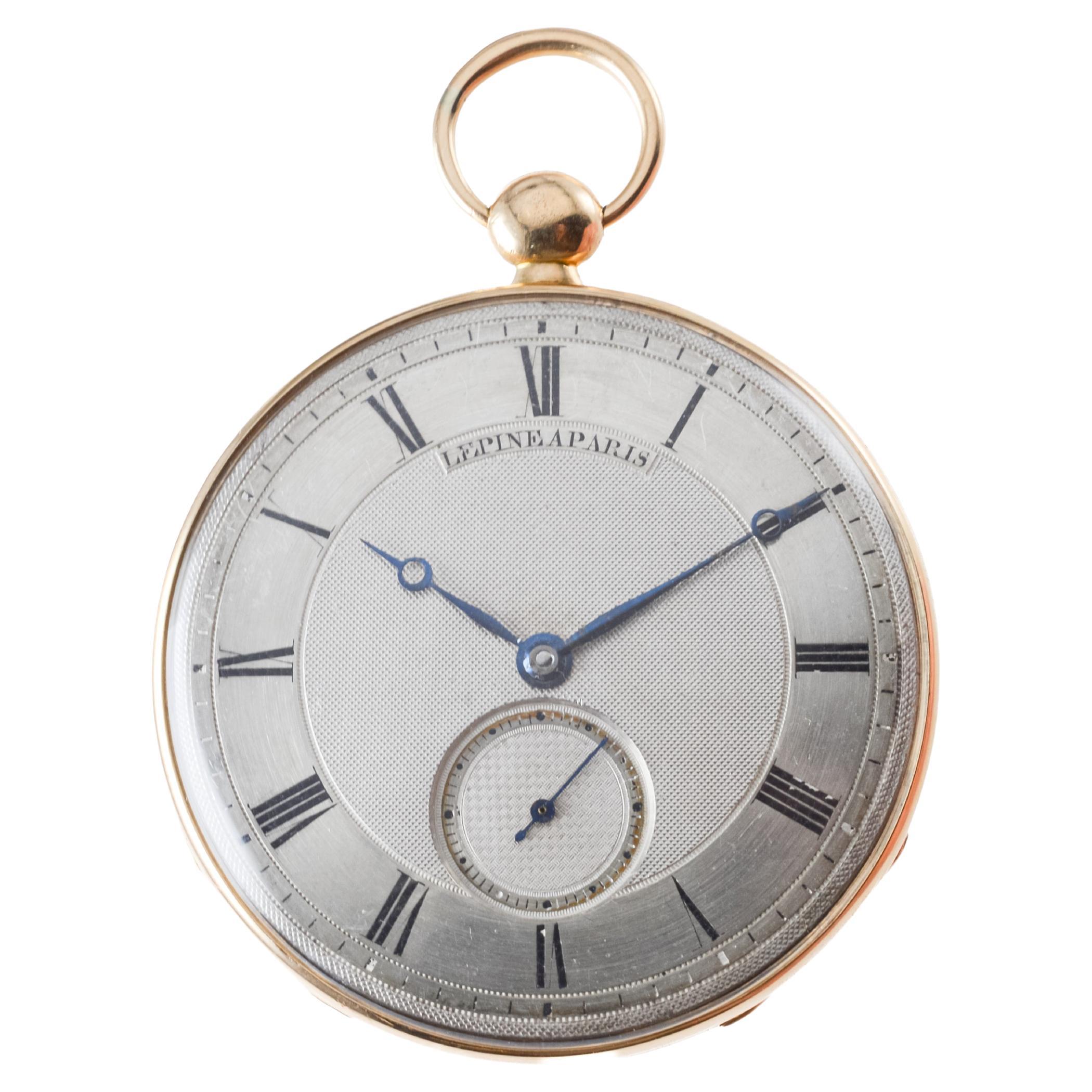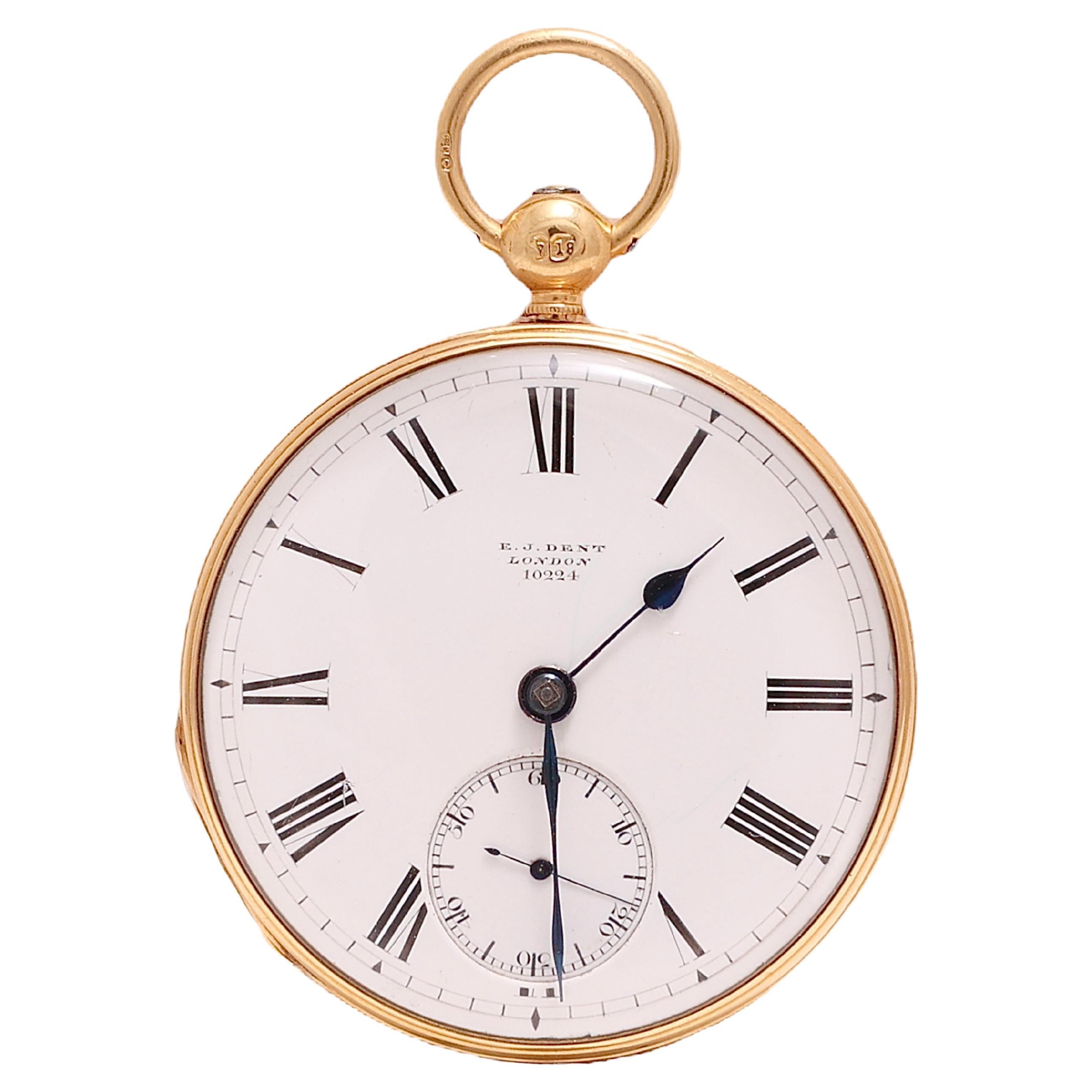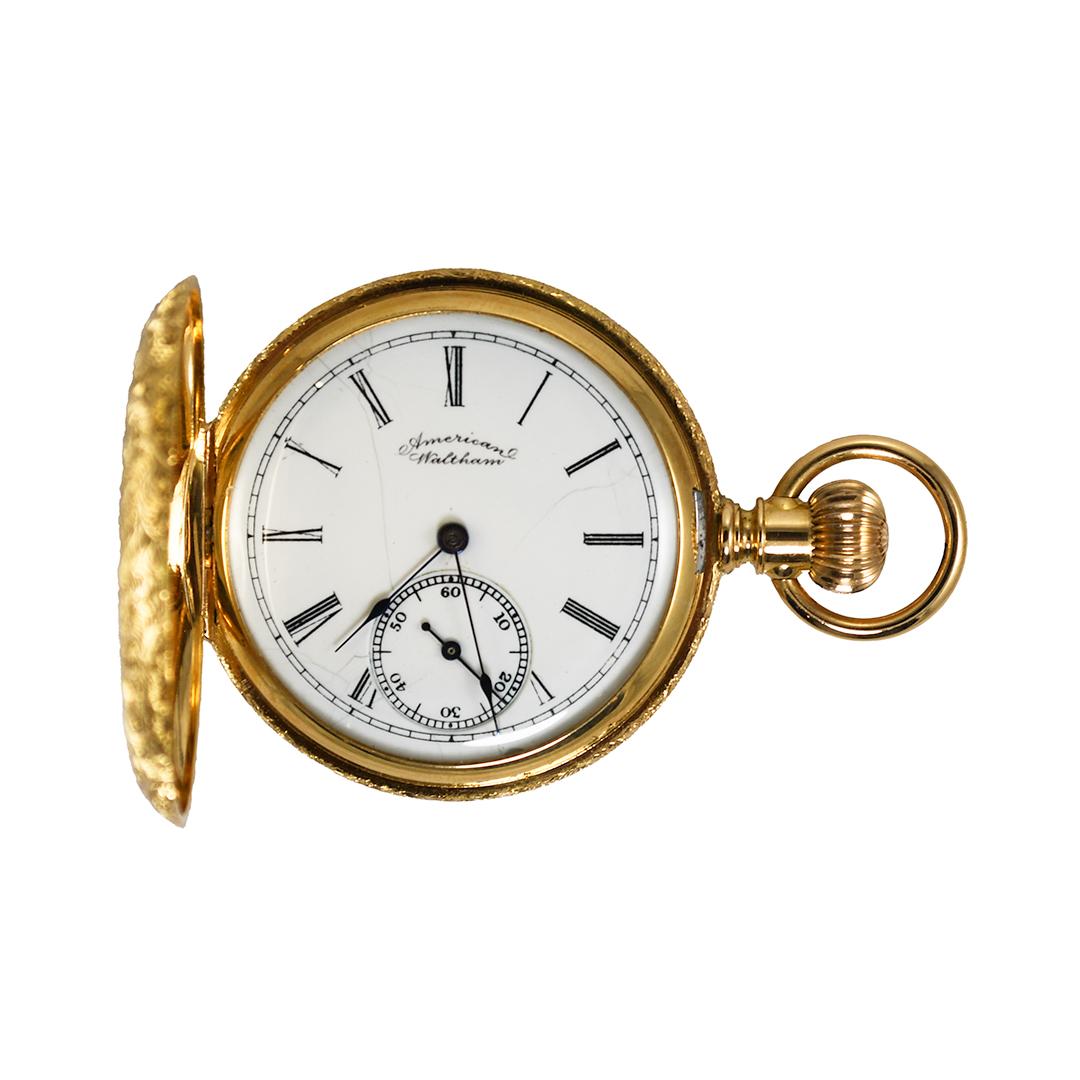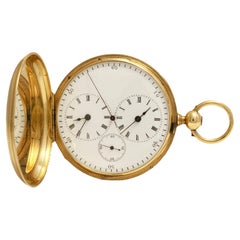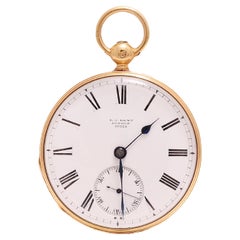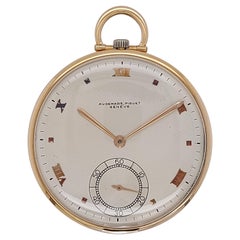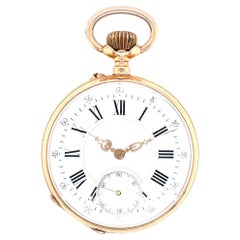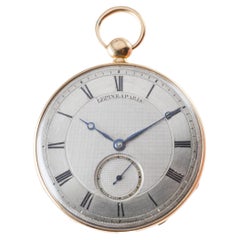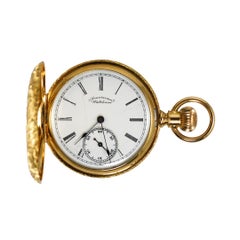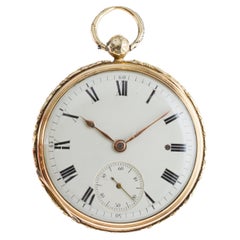Items Similar to 18 Kt Yellow Gold Lepine Pocket Watch, Second Morte, Double Barrel, Collector
Video Loading
Want more images or videos?
Request additional images or videos from the seller
1 of 17
18 Kt Yellow Gold Lepine Pocket Watch, Second Morte, Double Barrel, Collector
About the Item
18 Kt Solid Yellow Gold Lépine pocket watch Second Morte & Double Winding Barrel, Chronograph in Amazing Collectors Condition
Function : Seconde Morte with Stop function which was used as chronograph seconds counter
Movement : Mechanical Manual Winding with Double Barrel Winding !!!!!!!!!!!
Dial : Enamel
Case: 48 mm, thickness 11.5 mm
Total weight: 97.2 gram / 3.430 oz / 62.5 dwt
Jean-Antoine Lépine (alternatively spelled L’Pine, LePine, Lepine, L’Epine, born Jean-Antoine Depigny; 18 November 1720 – 31 May 1814) was a French watchmaker. He contributed inventions which are still used in watchmaking today and was amongst the finest French watchmakers, who were contemporary world leaders in the field.[1]
Beginnings and appointment as clockmaker to the King
Since his childhood the horologist showed an inclination towards mechanical, beginning his horological career and making fast progress, in particular, under the direction of Mr. Decroze, manufacturer of Saconnex watches,[2] in the suburbs of Geneva (Switzerland).
He moved to Paris in 1744 when he was 24 years of age, serving as apprentice to André-Charles Caron (1698–1775), at that time clockmaker to Louis XV. In 1756 he married Caron's daughter and associated with him, under "Caron et Lépine", between 1756 and 1769.[3] Watches with a signature Caron et Lépine or equivalent are not known; apparently Lépine was independent to a certain extent. As early watches were not numbered, it is uncertain when Lépine began to sign watches with Lépine à Paris on the movement and partially L'Epine à Paris on the dial.
On 12 March 1762, he became maître horloger (master horologist) and probably since that year he was teacher of Abraham-Louis Breguet, to whom he had a business relation over many years. In the Breguet archive many watches are recorded as delivered by Lépine.
In 1765 or 1766 (precise date not known), he was appointed Horloger du Roi (Clockmaker to the King).
In 1766 he succeeded Caron, and appeared on the list of Paris clockmakers of that year as Jean-Antoine Lépine, Hger du Roy, rue Saint Denis, Place Saint Eustache. Ten years later, in 1772, he established himself in the Place Dauphine; in 1778-1779, Quai de l’Horloge du Palais; then in the rue des Fossés Saint Germain l’Auxerrois near the Louvre in 1781; and finally at 12 Place des Victoires in 1789. In 1782, his daughter Pauline married one of his workmen, Claude-Pierre Raguet (1753–1810), with whom he formed a partnership in 1792.
He was also associated for a certain period with the philosopher Voltaire, at his watch manufactory set up in 1770 at Ferney. It is not known the exact role he played in the Ferney Manufacture royale, either technical director and/or associate. However, most ebauches for his watches were made there, at least between 1778 and 1782. An unsigned memoir of 1784 reports that Lépine stayed in Ferney for 18 months and that he had watch movements made there with a value of 90,000 livres a year.
As a clock and watchmaker to Louis XV, Louis XVI and Napoleon Bonaparte, Lépine's creations were well respected and in demand.[3]
1764/65: Invention of the revolutionary Lépine calibre
Lepine Caliber IIA with Quarter Repeater Complication shared with Abraham Breguet
Lepine Cuvette
Lepine Caliber IIA with Quarter Repeater. Also made by Lepine for Breguet watches.
Around 1764/65, he devised a means of manufacturing a pocket watch that could be thinner, favouring the onward quest for further miniaturization. His radical design broke with a 300-year tradition and ushered in the age of precision timekeeping, the modern pocket watch was born.[4]
In addition to paving the way for the making of even thinner watches, this innovation was readily adaptable as the basic model for mass-producing watch-movements, a process that was to begin in the nineteenth century. Up to the 1840s, watches were all hand-finished, so that parts were not interchangeable. The Swiss, Leschot in particular, believed there was a market for cheaper, machine made watches with interchangeable parts.[5] Refusing the incipient industrialization, French watch making only survived by becoming a peripheral adjunct to the Swiss watch making powerhouse, with only a few isolated Parisian cabinotiers still making truly French watches with French movements.[6]
The usual practice in the 18th century was to have the movement between two parallel plates and the balance wheel outside the top plate. The Lépine calibre discarded the top plate altogether and used individual cocks mounted on a single plate. This arrangement made it easier to assemble and repair the pocket watches, but also allowed the balance to be set to one side.
Essentially, the "Lépine calibre" or "calibre à pont", served to reduce a watch's thickness. To do this, it exchanged the traditional frame with two bottom plates for a single plate onto which the train is fixed with independent bridges. It also removed the fusee and its chain and then began using the cylinder escapement. He also invented the floating mainspring going barrel.
The Lépine calibre uses bars and bridges instead of pillars and upper plates. As mentioned, the movement has no fusee which equalizes the driving power transmitted to the train, replaced instead by a going barrel to drive the train directly. This improvement was facilitated by using the cylinder escapement and enhanced springs.
The calibre was quickly adopted throughout France and today its basic design is what characterizes all mechanical watches. It is important to note that the term "Lépine" can refer to both the calibre itself or a type of pocket watch with a flat, open-faced case in which the second wheel is placed in the axis of the winder shaft and the crown positioned at XII,[7] in opposition to the savonete (or hunter-case) watch where the second wheel and winder shaft are placed on perpendicular axes and the crown at III. This design has been known within the watch industry as the Lépine style ever since.[4]
Lépine's work profoundly influenced all subsequent watchmaking, particularly Abraham Louis Breguet who used a modified version of the "calibre ponts" for his ultra slim watches. Indeed, except from the very start of his career the celebrated and extremely well known Breguet almost always used Lépine calibres and then modified them. Along with Ferdinand Berthoud Lépine was master of Breguet.[8]
Other improvements and inventions
Throughout his career Lépine contributed with other important inventions[9] such as:
He modified Jean-André Lepaute's virgule escapement. Thanks to Jean Antoine Lépine, it would be used for some twenty years or so in France.
Invented a new repeating mechanism; in 1763 devised a mechanism in which by depressing the pendant the repeating spring is wound and where the hour and quarter racks were placed directly on the winding arbor. The new design was a great improvement, eliminating the fragile winding chain. It also gave the system better stability and decreased friction, while saving room and simplifying the mechanism. The 1763 Mémoire of the Académie des Sciences, in the chapter "Machines ou inventions approuvées par l’Académie en 1763", gave a very favorable report of Lépine's invention. The idea, with some modifications, still survives today.
Invented a winding system requiring no key.
Invented "lost hinge" watchcases (invisible); his "secret" opening mechanism with hidden hinges, releasing the back cover by twisting the pendant.
The first horologist to have continuously study and work on aesthetic design, in the modern meaning of the word, on watches. This was continued by Breguet, etc.
He was also the first one to use Arabic numerals on dials as many for the hours as for the minutes.
Lépine is also credited for introducing hand-setting at the back of the watch and the hunter case (or savonette) that completely covers a dial with its spring-loaded hinged panel.
He developed a new form of case, à charnières perdues (with concealed hinges) and a fixed bezel. Since these watches were rewound and set from the rear, the movement was protected from dust by an inner case. This new arrangement had the advantage of preventing access from the dial face, thus avoiding damaging it or the hands.
The aiguilles à pomme apple shaped hands; hollow, tip hands, were first used by Lépine. In 1783 Breguet introduced a variation with eccentric "moon", and these are the most popular today, known as Breguet hands.
Legacy
In 1793–94 Lépine, when his tired eyes did not let him work further, handed over the "Maison Lépine" to his son-in-law Claude-Pierre Raguet who had become an associate in 1792, and when he died in 1810, his son Alexandre Raguet-Lépine continued the business. However, Jean-Antoine Lépine continued to be active in the firm until his demise, happened on May 31, 1814 at his home of Rue St. Anne in Paris. He was buried in a temporary concession in the Père-Lachaise cemetery on June 1, 1814.
The business was sold to Jean Paul Chapuy in 1815, employing Lepine's nephew Jacques Lépine (working from 1814 until 1825) who had been appointed clockmaker to the King of Westfalia (Germany) in 1809.[2] Later in 1827 it was sold to Deschamps who was succeeded in 1832 by Fabre (Favre). In 1853 passed to Boulay. 1885: Roux, Boulay's son in law. 1901: Ferdinand Verger. 1914: Last acquisition. 1919: Residual stock purchased by Louis Leroy. The business always continued under the name Lépine.[10]
Several of Lepine clocks and watches are on display in European museums and palaces, his timepieces are among the finest in the history of watchmaking.
He played a significant role in allowing us to strap watches onto our wrists.[3]
Historical associations
The horologist was patronised by leading figures of his day including the Comtesse d'Artois and de Provence, many French aristocracy as well as the Spanish, British and Swedish royalty.[11] Apart from monarchs, aristocrats, bourgeoises, etc., such was the popularity of Lépine's design that George Washington,[12] retired as President of the United States, searched for:
Dear Sir, I had the pleasure to receive by the last mail your letter dated the 12th of this month. I am much obliged by your offer of executing commissions for me in Europe, and shall take the liberty of charging you with one only. I wish to have a good gold watch procured for my own use; not a small, trifling, nor finically ornamented one, but a watch well executed in point of workmanship, and of about the size and kind of that which was procured by Mr. (Thomas) Jefferson for Mr. (James) Madison, which was large and flat. I imagine Mr. Jefferson can give you the best advice on the subject, as I am told this species of watches, which I have described, can be found cheaper and better fabricated in Paris than in London. (...)"
[13] Letter from George Washington to Gouverneur Morris. Mount Vernon, 28 November 1788.
The pocket watch he received through his emissary in Paris was from '"Mr. Lépine (who) is at the Head of his Profession here, and in Consequence asks more for his Work than any Body else. I therefore waited on Mr. L'Epine and agreed with him for two Watches exactly alike, one of which be for you and the other for me".[14] Gouverneur Morris in Paris 23 February 1789.
- Creator:Jean-Antoine Lepine
- Case Material:
- Weight:97.2 g
- Strap Material:Gold
- Case Shape:Round
- Movement:
- Case Dimensions:Diameter: 1.89 in (48 mm)
- Style:
- Place of Origin:
- Period:
- Date of Manufacture:unknown
- Condition:
- Seller Location:Antwerp, BE
- Reference Number:Seller: #85801stDibs: LU1752221651652
About the Seller
5.0
Gold Seller
Premium sellers maintaining a 4.3+ rating and 24-hour response times
Established in 1998
1stDibs seller since 2019
193 sales on 1stDibs
Typical response time: 2 hours
- ShippingRetrieving quote...Shipping from: 2018, Belgium
- Return Policy
Authenticity Guarantee
In the unlikely event there’s an issue with an item’s authenticity, contact us within 1 year for a full refund. DetailsMoney-Back Guarantee
If your item is not as described, is damaged in transit, or does not arrive, contact us within 7 days for a full refund. Details24-Hour Cancellation
You have a 24-hour grace period in which to reconsider your purchase, with no questions asked.Vetted Professional Sellers
Our world-class sellers must adhere to strict standards for service and quality, maintaining the integrity of our listings.Price-Match Guarantee
If you find that a seller listed the same item for a lower price elsewhere, we’ll match it.Trusted Global Delivery
Our best-in-class carrier network provides specialized shipping options worldwide, including custom delivery.More From This Seller
View All18 kt. Gold Dual Time, Dead Beat Second, Double Barrel A.Perret Pocket Watch
Located in Antwerp, BE
18 kt. Gold Dual Time, Dead Beat Second, Double Barrel Pocket Watch A.Perret
Movement: Mechanical with manual winding
Functions: hours,minutes, Dead Second Beat and sweep second; ...
Category
Antique 19th Century Swiss Artisan Pocket Watches
Materials
Gold, 18k Gold
18kt Yellow Octagonal Gold Audemars Piguet Royal Oak Pocket Watch
By Audemars Piguet
Located in Antwerp, BE
18kt Yellow Gold Octagonal Audemars Piguet Royal Oak Pocket Watch
Reference: 5691BA
Calibre: 5020
Movement: Mechanical movement, Manual Winding
Case: 18kt Yellow gold, measuremen...
Category
Vintage 1980s Artisan Pocket Watches
Materials
Gold, 18k Gold, Yellow Gold
18 Kt Gold E.J Dent London, Yellow Gold, Open Face Verge Pocket watch
Located in Antwerp, BE
E.J Dent London, Yellow Gold Open Face Verge Pocket watch
Case: 18 Kt Solid Yellow Gold Diameter 45.5 mm, thickness 12.2 mm
Total weight: 68.9 gram / 2...
Category
Antique 19th Century British Artisan Pocket Watches
Materials
18k Gold, Yellow Gold
Fine Slim Vintage 18kt Yellow Gold Audemars Piguet Pocket Watch, 19 Jewels
By Audemars Piguet
Located in Antwerp, BE
Fine slim Vintage 18kt Yellow Gold Audemars Piguet pocket watch.
A collector watch.
Movement: Beautifully toned 19 jewel 8 adjustment movement.
Case: 18kt Yellow Gold, Diameter 41 mm,
Dial: Goldish Dial with applied roman numerals and gold indexes.
Total weight: 37.3 gram / 1.315 oz / 24 dwt
Signed: Movement signed; Audemars Piguet Swiss, Nineteen 19 Jewels, Eight 8 Adjustments, Serial number.
Dial signed with: Audemars Piguet Geneve...
Category
20th Century Swiss Artisan Pocket Watches
Materials
18k Gold, Yellow Gold
Excellent Condition 14kt Yellow Gold Omega Pocket Watch, Calibre 163, Gold Dial
By Omega
Located in Antwerp, BE
In Excellent condition 14kt Yellow Gold Omega Pocket watch, Calibre 163, Gold Dial
Calibre: 163
Movement: The movement is signed Omega Swiss,...
Category
20th Century Artisan Pocket Watches
Materials
18k Gold, Yellow Gold, Gilt Metal
IWC Schaffhausen Asprey Savonette/Hunting Case Pocket Watch 18 Kt Gold
By IWC
Located in Antwerp, BE
Unique Beautiful and Collectable IWC Savonette/Hunting Case Pocket watch made For Asprey.
49mm 18k yellow gold hunting case with double caseback.
Ivory dial with large Arabic numer...
Category
20th Century Artisan Pocket Watches
Materials
Gold
You May Also Like
Antique 18K Gold Lépine Pocket Watch
Located in Vannes, FR
Antique Lépine Pocket Watch in 18 Carat Gold - Enamel Dial and Roman Numerals
Material: Yellow gold case, 18 carats, of a remarkable finesse and brightness.
Dial: Delicate white enamel adorned with roman numerals for the hours and arabic indexes for the minutes, a classic and legible design.
Needles: Pistol-style, finely crafted for a sophisticated look.
Movement: High precision mechanical movement equipped with an anchor exhaust in straight line.
Specifications: Breguet Spiral and 19 rubies, guaranteeing optimal performance and increased durability.
Condition: Excellent antique condition with a light patina and natural wear marks consistent with its age. Additional details:
Authenticity: Original components, including crown and reassembly mechanism.
Style: The Lépine case is minimalist and thin, a feature that collectors love.
Rarity: The 19th century Lépine watches...
Category
Vintage 1920s French Art Deco Pocket Watches
Materials
18k Gold
Antoine Lepine Rose Gold Ruby Cylinder French Pocket Watch, circa 1800s
Located in Long Beach, CA
FACTORY / HOUSE: Lepine
STYLE / REFERENCE: Oversized Open Faced Pocket Watch
METAL / MATERIAL: 18Kt Rose Gold
DIMENSIONS: Diameter 59mm
CIRCA / YEAR: 1800's
MOVEMENT / CALIBER: Key ...
Category
Antique Early 1800s French Art Deco Pocket Watches
18K Yellow Gold Waltham Pocket Watch Size 6
Located in Laguna Beach, CA
18k yellow gold Waltham Pocket watch with a hunting case.
Model 1890, Size 6, serial number 5506199, 15 to 17 jewels.
Fancy engraved movement.
The case is stamped 18k U.S. Assay.
The...
Category
Mid-20th Century Pocket Watches
Materials
18k Gold, Yellow Gold
Jean-Antoine Lepine Rose Gold Ruby Cylinder French Pocket Watch, circa 1780
Located in Long Beach, CA
FACTORY / HOUSE: Lepine
STYLE / REFERENCE: Oversized Open Faced Pocket Watch
METAL / MATERIAL: 18Kt. Rose Gold
DIMENSIONS: Diameter 59mm
CIRCA: 1770 / 80's
MOVEMENT / CALIBER: Key W...
Category
Antique Late 18th Century French Art Deco Pocket Watches
Materials
Rose Gold
R. Lannier 18k Yellow Gold Men's Pocket Watch
Located in Dallas, TX
R. Lannier 18k Yellow Gold Men's Pocket Watch - Manual winding; pivoted detent pocket chronometer. 18k yellow gold with initials (51 mm diameter). White dial with Roman numerals; s...
Category
20th Century Pocket Watches
English 18 Karat Yellow Gold Pocket Watch
Located in Dallas, TX
English 18K Yellow Gold Pocket Watch - Manual winding . 18K yellow gold case ( 53 mm ) . White dial with Roman numerals with sunken sub second dial . Signed WM Robinson. Pre-owned wi...
Category
20th Century British Pocket Watches
Recently Viewed
View AllMore Ways To Browse
Antique Sign Collectors
Dior Pocket
Breguet Antique
Antique Yellow Pine
1793 France
Sons Of Liberty
Small Antique Barrel
Antique German Watch
Open Well Clock
Louis Saint Jacques
Wind Direction
18th Century Spanish Plates
Antique 3 Wheeler
Louis 12th
Thomas Clocks Antique
Apple Head
19th Century Swiss Clocks
Miniature Case Clock
